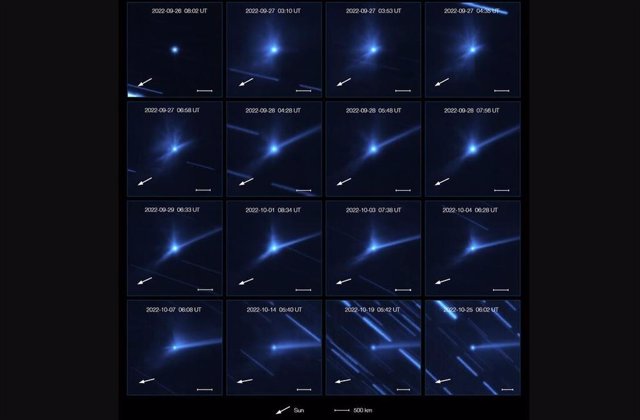March 23 () –
Using the Very Large Telescope (VLT), two teams of astronomers have observed the aftermath of the collision between the spacecraft DART (Double Asteroid Redirection Test) from NASA and the asteroid Dimorphos.
The controlled impact was a test of planetary defense, but it also provided the astronomical community with a unique opportunity to learn more about the composition of the asteroid from the ejected material.
On September 26, 2022the DART spacecraft collided with the Dimorphos asteroid in a controlled test of our asteroid deflection capabilities. The impact took place 11 million kilometers away from Earth., close enough to be observed in detail with many telescopes. ESO’s four 8.2-metre VLT telescopes in Chile observed the aftermath of the impact, and the first results of these VLT observations have been published in two scientific papers.
“Asteroids are some of the most basic relics of material from which all the planets and moons in our Solar System were created,” he stated. it’s a statement Brian Murphy, a PhD student at the University of Edinburgh and co-author of one of the studies. Therefore, studying the cloud of material ejected after the DART impact can tell us how our Solar System formed. “Impacts between asteroids occur naturally, but you never know in advance,” continues Cyrielle Opitom, also an astronomer at the University of Edinburgh and lead author of one of the papers. “DART is a great opportunity to study a controlled impact, almost like a laboratory.”
Opitom and his team followed the evolution of the debris cloud for a month with the Multi Unit Spectroscopic Explorer (MUSE) instrument, installed on ESO’s VLT. They found that the ejected cloud was bluer than the asteroid itself before impact, indicating that the cloud could be made of very fine particles. In the hours and days that followed the impact, other structures developed: cumulus clouds, spirals, and a long tail pushed by radiation from the Sun. The spirals and tail were redder than the initial cloud, so they could be made of larger particles.
MUSE allowed the Opitom team to split the light from the cloud into a rainbow-like pattern and search for the chemical signatures of different gases. In particular, they looked for oxygen and water from the ice exposed by the impact. But they found nothing. “Asteroids are not expected to contain significant amounts of ice, so detecting any trace of water would have been a real surprise,” explains Opitom. They also searched for traces of the fuel from the DART spacecraft, but found none. “We knew it was a long shot“, he says, “since the amount of gas remaining in the propulsion system tanks would not have been very large. Also, some of it would already have traveled too far to detect with MUSE when we started looking.”
Another team, led by Stefano Bagnulo, an astronomer at Armagh Observatory and Planetarium in the UK, studied how the DART impact altered the asteroid’s surface.
“When we observe the objects of our Solar System, we see the sunlight that is scattered by its surface or by its atmosphere, which is partially polarized,” explains Bagnulo. This means that the light waves oscillate along a preferred direction, rather than randomly. “Track how polarization changes with the asteroid’s orientation relative to us and the Sun reveals the structure and composition of its surface”.
Bagnulo and his colleagues used the FOcal Reducer / Low dispersion Spectrograph 2 (FORS2) instrument, installed on the VLT, to monitor the asteroid, and detected that the polarization level dropped suddenly after impact. At the same time, the overall brightness of the system increased. One possible explanation would be that the impact exposed more pristine material from inside the asteroid. “Perhaps the material excavated by the impact was inherently brighter and less polarized than material present on the surface.since it was never exposed to solar wind or solar radiation”says Bagnulo.
Another possibility is that the impact destroyed particles on the surface, thus ejecting much smaller ones into the debris cloud. “We know that, under certain circumstances, smaller fragments are more efficient at reflecting light and less efficient at polarizing it,” explains Zuri Gray, a PhD student also at Armagh Observatory and Planetarium.
The studies carried out by the teams led by Bagnulo and Opitom show the potential of the VLT when its different instruments work together. In fact, in addition to MUSE and FORS2, impact aftermath was observed with two other VLT instruments, and analysis of these data is ongoing.
“This research took advantage of a unique opportunity when NASA had a spacecraft impact an asteroid,” concludes Opitom, “so it is not possible to repeat it with any future facility. This makes the data obtained with the VLT at the moment of impact extremely valuable in terms of improving our understanding of the nature of asteroids.















![[Img #74803]](https://thelatestnews.world/wp-content/uploads/2025/01/Discovery-and-exploration-of-Jupiters-4-main-moons-300x200.jpg)